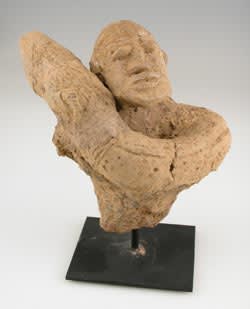Djenne Sculpture of a Snake Charmer, 12th Century CE - 16th Century CE
Terracotta
6.375 x 7
PF.5808
Further images
Since the very beginnings of time, on every continent of this earth where humanity has worshipped divinity, the serpent has been recognized and revered as a god. From Africa's steaming...
Since the very beginnings of time, on every continent of this earth where humanity has worshipped divinity, the serpent has been recognized and revered as a god. From Africa's steaming jungle to the icy wastelands of northern Europe; from the Fertile Crescent to the deserted outback of Australia the serpent has been worshipped, feared and adored. Serpent mythology is arguably the most widespread mythology known to mankind. Perhaps the greatest attribute of the snake is its apparent immortality. The snake can shed its skin, liberating itself of all scars and rejuvenating itself without pain or bloodshed. Thus the snake can be viewed as a symbol of rebirth and the afterlife. To discern the significance of snakes in African mythology, one need not look further than the great Pharaoh’s crown. Thus, from the earliest chapters of history, the serpent has been associated with royalty and power. This terracotta comes from the lost culture of Djenne, named for the town near where many of the artifacts were unearthed. The intertwining relations of snake and man are apparent. Perhaps this terracotta fragment represents a myth; perhaps this figure is a snake charmer or wrestler. African myths often speak of a snake that encircles the entire globe, connected with its tail in its mouth, a sign of infinity. The treatment of the snake’s head conveys the respect and admiration for this creature. The sculptor has even carved the same protruding lenticular eyes that characterize Djenne art on the snake. The sculptor has also attempted to depict the pattern and texture of the snakes skin. The reverence for this beast is apparent in this sculpture. Alas, as this serpent wraps itself around this man, so the destinies of snakes and humans seem to be intertwined.









